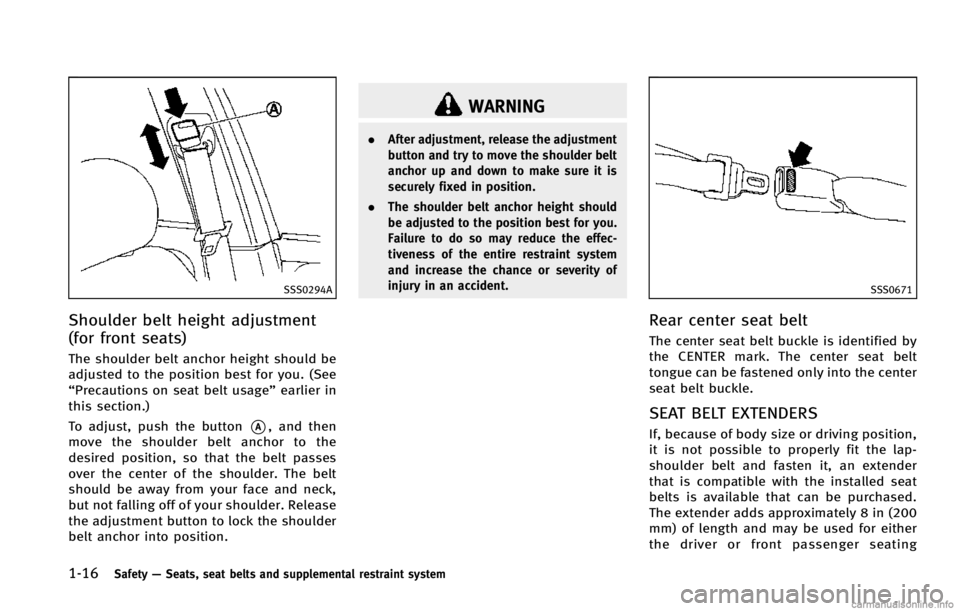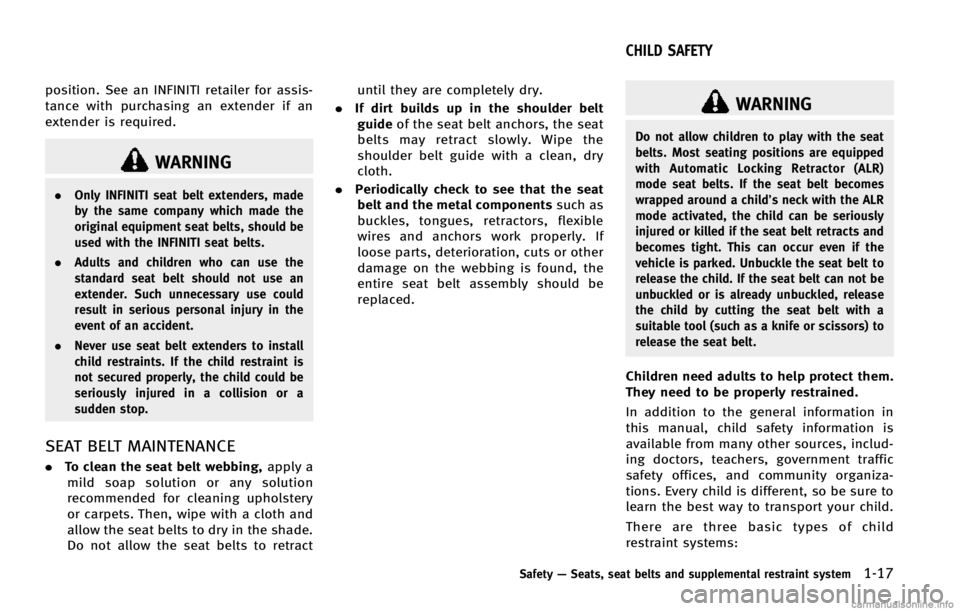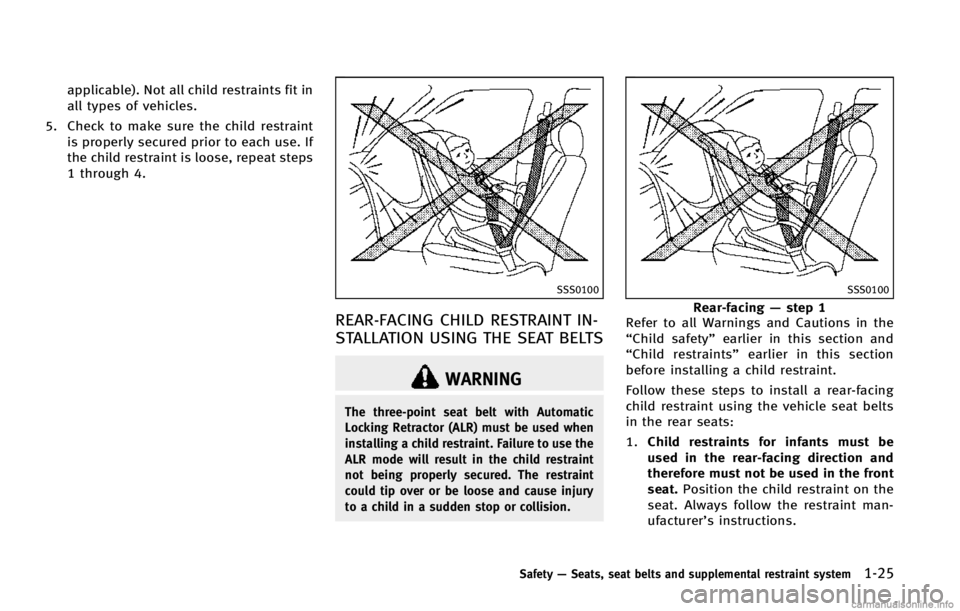lock INFINITI EX 2013 User Guide
[x] Cancel search | Manufacturer: INFINITI, Model Year: 2013, Model line: EX, Model: INFINITI EX 2013Pages: 498, PDF Size: 2.5 MB
Page 33 of 498

1-14Safety—Seats, seat belts and supplemental restraint system
SSS0292
Fastening the seat belts
1. Adjust the seat. (See “Seats”earlier in
this section.)
2. Slowly pull the seat belt out of the retractor and insert the tongue into the
buckle until you hear and feel the latch
engage.
.The retractor is designed to lockduring a sudden stop or on impact.
A slow pulling motion permits the
belt to move, and allows you some
freedom of movement in the seat.
.If the seat belt cannot be pulled
from its fully retracted position, firmly pull the belt and release it.
Then smoothly pull the belt out of
the retractor.
SSS0290
3. Position the lap belt portion
low and
snug on the hips as shown.
4. Pull the shoulder belt portion toward the retractor to take up extra slack. Be
sure the shoulder belt is routed over
your shoulder and across your chest.
The front passenger and rear passenger
seating positions’ three-point seat belts
have two modes of operation:
. Emergency Locking Retractor (ELR)
. Automatic Locking Retractor (ALR)
The Emergency Locking Retractor (ELR)
mode allows the seat belt to extend and
retract to allow the driver and passengers
Page 34 of 498

some freedom of movement in the seat.
The ELR locks the seat belt when the
vehicle slows down rapidly or during
impacts.
The Automatic Locking Retractor (ALR)
mode (child restraint mode) locks the seat
belt for child restraint installation.
When the ALR mode is activated the seat
belt cannot be extended again until the
seat belt tongue is detached from the
buckle and fully retracted. The seat belt
returns to the ELR mode after the seat belt
fully retracts. For additional information,
see“Child restraints” later in this section.
The ALR mode should be used only for
child restraint installation. During normal
seat belt use by a passenger, the ALR
mode should not be activated. If it is
activated it may cause uncomfortable seat
belt tension.
WARNING
When fastening the seat belts, be certain
that seatbacks are completely secured in
the latched position. If they are not com-
pletely secured, passengers may be injured
in an accident or sudden stop.
SSS0326
Unfastening the seat belts
To unfasten the seat belt, push the button
on the buckle. The seat belt automatically
retracts.
Checking seat belt operation
Seat belt retractors are designed to lock
seat belt movement by two separate
methods:
. When the belt is pulled quickly from the
retractor.
. When the vehicle slows down rapidly.
To increase your confidence in the seat
belts, check the operation as follows: .
Grasp the shoulder belt and pull
forward quickly. The retractor should
lock and restrict further belt movement.
If the retractor does not lock during this
check or if you have any question about
seat belt operation, see an INFINITI retailer.
Safety —Seats, seat belts and supplemental restraint system1-15
Page 35 of 498

1-16Safety—Seats, seat belts and supplemental restraint system
SSS0294A
Shoulder belt height adjustment
(for front seats)
The shoulder belt anchor height should be
adjusted to the position best for you. (See
“Precautions on seat belt usage” earlier in
this section.)
To adjust, push the button
*A, and then
move the shoulder belt anchor to the
desired position, so that the belt passes
over the center of the shoulder. The belt
should be away from your face and neck,
but not falling off of your shoulder. Release
the adjustment button to lock the shoulder
belt anchor into position.
WARNING
. After adjustment, release the adjustment
button and try to move the shoulder belt
anchor up and down to make sure it is
securely fixed in position.
. The shoulder belt anchor height should
be adjusted to the position best for you.
Failure to do so may reduce the effec-
tiveness of the entire restraint system
and increase the chance or severity of
injury in an accident.
SSS0671
Rear center seat belt
The center seat belt buckle is identified by
the CENTER mark. The center seat belt
tongue can be fastened only into the center
seat belt buckle.
SEAT BELT EXTENDERS
If, because of body size or driving position,
it is not possible to properly fit the lap-
shoulder belt and fasten it, an extender
that is compatible with the installed seat
belts is available that can be purchased.
The extender adds approximately 8 in (200
mm) of length and may be used for either
the driver or front passenger seating
Page 36 of 498

position. See an INFINITI retailer for assis-
tance with purchasing an extender if an
extender is required.
WARNING
.Only INFINITI seat belt extenders, made
by the same company which made the
original equipment seat belts, should be
used with the INFINITI seat belts.
. Adults and children who can use the
standard seat belt should not use an
extender. Such unnecessary use could
result in serious personal injury in the
event of an accident.
. Never use seat belt extenders to install
child restraints. If the child restraint is
not secured properly, the child could be
seriously injured in a collision or a
sudden stop.
SEAT BELT MAINTENANCE
.To clean the seat belt webbing, apply a
mild soap solution or any solution
recommended for cleaning upholstery
or carpets. Then, wipe with a cloth and
allow the seat belts to dry in the shade.
Do not allow the seat belts to retract until they are completely dry.
. If dirt builds up in the shoulder belt
guide of the seat belt anchors, the seat
belts may retract slowly. Wipe the
shoulder belt guide with a clean, dry
cloth.
. Periodically check to see that the seat
belt and the metal components such as
buckles, tongues, retractors, flexible
wires and anchors work properly. If
loose parts, deterioration, cuts or other
damage on the webbing is found, the
entire seat belt assembly should be
replaced.
WARNING
Do not allow children to play with the seat
belts. Most seating positions are equipped
with Automatic Locking Retractor (ALR)
mode seat belts. If the seat belt becomes
wrapped around a child’s neck with the ALR
mode activated, the child can be seriously
injured or killed if the seat belt retracts and
becomes tight. This can occur even if the
vehicle is parked. Unbuckle the seat belt to
release the child. If the seat belt can not be
unbuckled or is already unbuckled, release
the child by cutting the seat belt with a
suitable tool (such as a knife or scissors) to
release the seat belt.
Children need adults to help protect them.
They need to be properly restrained.
In addition to the general information in
this manual, child safety information is
available from many other sources, includ-
ing doctors, teachers, government traffic
safety offices, and community organiza-
tions. Every child is different, so be sure to
learn the best way to transport your child.
There are three basic types of child
restraint systems:
Safety —Seats, seat belts and supplemental restraint system1-17
CHILD SAFETY
Page 44 of 498

applicable). Not all child restraints fit in
all types of vehicles.
5. Check to make sure the child restraint is properly secured prior to each use. If
the child restraint is loose, repeat steps
1 through 4.
SSS0100
REAR-FACING CHILD RESTRAINT IN-
STALLATION USING THE SEAT BELTS
WARNING
The three-point seat belt with Automatic
Locking Retractor (ALR) must be used when
installing a child restraint. Failure to use the
ALR mode will result in the child restraint
not being properly secured. The restraint
could tip over or be loose and cause injury
to a child in a sudden stop or collision.
SSS0100
Rear-facing —step 1
Refer to all Warnings and Cautions in the
“Child safety ”earlier in this section and
“Child restraints” earlier in this section
before installing a child restraint.
Follow these steps to install a rear-facing
child restraint using the vehicle seat belts
in the rear seats:
1. Child restraints for infants must be
used in the rear-facing direction and
therefore must not be used in the front
seat. Position the child restraint on the
seat. Always follow the restraint man-
ufacturer’s instructions.
Safety —Seats, seat belts and supplemental restraint system1-25
Page 45 of 498

1-26Safety—Seats, seat belts and supplemental restraint system
SSS0654
Rear-facing —step 2
2. Route the seat belt tongue through the
child restraint and insert it into the
buckle until you hear and feel the latch
engage. Be sure to follow the child
restraint manufacturer’ s instructions
for belt routing.
SSS0655
Rear-facing —step 3
3. Pull the shoulder belt until the belt is
fully extended. At this time, the seat
belt retractor is in the Automatic Lock-
ing Retractor (ALR) mode (child restraint
mode). It reverts to the Emergency
Locking Retractor (ELR) mode when
the seat belt is fully retracted.
SSS0656
Rear-facing —step 4
4. Allow the seat belt to retract. Pull up on
the shoulder belt to remove any slack
in the belt.
Page 46 of 498

SSS0657
Rear-facing—step 5
5. Remove any additional slack from the
seat belt; press downward and rear-
ward firmly in the center of the child
restraint to compress the vehicle seat
cushion and seatback while pulling up
on the seat belt.
SSS0658
Rear-facing —step 6
6. After attaching the child restraint, test
it before you place the child in it. Push
it from side to side while holding the
child restraint near the seat belt path.
The child restraint should not move
more than 1 inch (25 mm), from side to
side. Try to tug it forward and check to
see if the belt holds the restraint in
place. If the restraint is not secure,
tighten the seat belt as necessary, or
put the restraint in another seat and
test it again. You may need to try a
different child restraint. Not all child
restraints fit in all types of vehicles. 7. Check to make sure that the child
restraint is properly secured prior to
each use. If the seat belt is not locked,
repeat steps 1 through 6.
After the child restraint is removed and the
seat belt fully retracted, the ALR mode
(child restraint mode) is canceled.
FORWARD-FACING CHILD RESTRAINT
INSTALLATION USING LATCH
Refer to all Warnings and Cautions in the
“Child safety ”earlier in this section and
“Child restraints” earlier in this section
before installing a child restraint.
Follow these steps to install a forward-
facing child restraint using the LATCH
system:
1. Position the child restraint on the seat.
Always follow the child restraint man-
ufacturer’s instructions.
Safety —Seats, seat belts and supplemental restraint system1-27
Page 48 of 498

SSS0647
Forward-facing—step 4
4. For child restraints that are equipped
with webbing-mounted attachments,
remove any additional slack from the
anchor attachments. Press downward
and rearward firmly in the center of the
child restraint with your knee to com-
press the vehicle seat cushion and
seatback while tightening the webbing
of the anchor attachments.
5. Tighten the tether strap according to the manufacturer’s instructions to re-
move any slack.
SSS0638
Forward-facing —step 6
6. After attaching the child restraint, test
it before you place the child in it. Push
it from side to side while holding the
child restraint near the LATCH attach-
ment path. The child restraint should
not move more than 1 inch (25 mm),
from side to side. Try to tug it forward
and check to see if the LATCH attach-
ment holds the restraint in place. If the
restraint is not secure, tighten the
LATCH attachment as necessary, or
put the restraint in another seat and
test it again. You may need to try a
different child restraint. Not all child
restraints fit in all types of vehicles. 7. Check to make sure the child restraint
is properly secured prior to each use. If
the child restraint is loose, repeat steps
1 through 6.
FORWARD-FACING CHILD RESTRAINT
INSTALLATION USING THE SEAT
BELTS
WARNING
The three-point seat belt with Automatic
Locking Retractor (ALR) must be used when
installing a child restraint. Failure to use the
ALR mode will result in the child restraint
not being properly secured. The restraint
could tip over or be loose and cause injury
to a child in a sudden stop or collision.
Safety —Seats, seat belts and supplemental restraint system1-29
Page 50 of 498

anchor.
SSS0651
Forward-facing—step 4
4. Pull the shoulder belt until the belt is
fully extended. At this time, the seat
belt retractor is in the Automatic Lock-
ing Retractor (ALR) mode (child restraint
mode). It reverts to Emergency Locking
Retractor (ELR) mode when the seat belt
is fully retracted.
SSS0652
Forward-facing —step 5
5. Allow the seat belt to retract. Pull up on
the shoulder belt to remove any slack
in the belt.
Safety —Seats, seat belts and supplemental restraint system1-31
Page 51 of 498

1-32Safety—Seats, seat belts and supplemental restraint system
SSS0653
Forward-facing —step 6
6. Remove any additional slack from the
seat belt; press downward and rear-
ward firmly in the center of the child
restraint with your knee to compress
the vehicle seat cushion and seatback
while pulling up on the seat belt.
7. Tighten the tether strap according to the manufacturer’s instructions to re-
move any slack.
SSS0641
Forward-facing —step 8
8. After attaching the child restraint, test
it before you place the child in it. Push
it from side to side while holding the
child restraint near the seat belt path.
The child restraint should not move
more than 1 inch (25 mm), from side to
side. Try to tug it forward and check to
see if the belt holds the restraint in
place. If the restraint is not secure,
tighten the seat belt as necessary, or
put the restraint in another seat and
test it again. You may need to try a
different child restraint. Not all child
restraints fit in all types of vehicles. 9. Check to make sure the child restraint
is properly secured prior to each use. If
the seat belt is not locked, repeat steps
2 through 8.